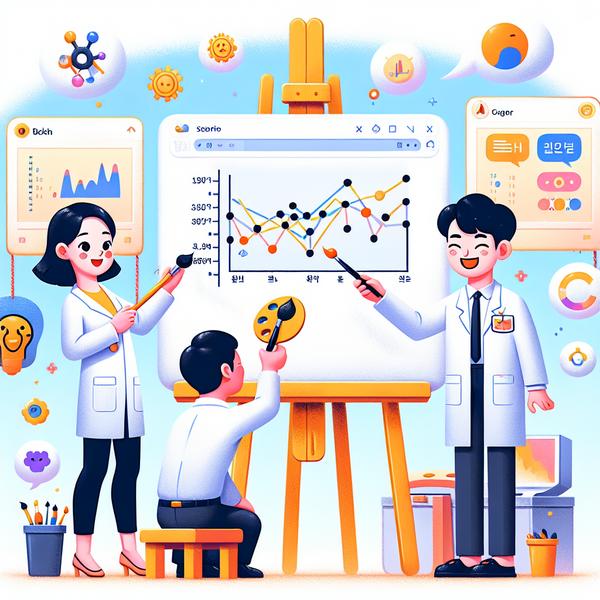
Creating visually stunning and fully interactive dashboards has always been a fascinating aspect of data visualization. This tutorial explores how developers can create such dashboards using Bokeh and custom JavaScript. By blending Python's analytical power with JavaScript’s interactive capabilities, we can craft a dynamic dashboard experience. From scatter plots to real-time data streaming, this approach demonstrates how to redefine the way we visualize and interact with data in intuitive browsers. The tutorial also dives into specific techniques like linked brushing, color mapping, and widget-based interactivity to elevate usability.
Getting Started with Bokeh: Building the Foundation
- Bokeh is like a powerful artist's brush for data visualizations, perfect for making interactive visuals straight in the browser.
- To start, set up the environment by installing libraries like Bokeh, Pandas, and NumPy. Think of this as gathering tools before painting a masterpiece.
- Next, create a dataset. For instance, we generated synthetic data mimicking sensor readings: temperature, pressure, and humidity. This was achieved using NumPy’s random functionalities, similar to how a baker prepares ingredients for a cake.
- The first project involves plotting a scatter chart to visualize temperature against pressure. Using circle markers and hover tools, this plot provides insights at a glance and adds interactive tooltips for more detailed exploration.
- Visualizing datasets this way takes raw numbers and transforms them into an engaging story, making it easier for users to derive actionable insights.
Enhancing Visuals with Linked Brushing and Gradients
- To uncover correlations, we linked multiple charts – for example, showing humidity vs. temperature alongside pressure vs. temperature. This is called linked brushing.
- Linked brushing allows interactions with one graph to dynamically update another. Imagine a set of interconnected gears; moving one impacts the others, allowing seamless exploration of relationships between variables.
- Additionally, to make visuals more striking, color gradients were added. For instance, using Bokeh’s LinearColorMapper, different humidity levels were denoted by varied colors.
- A color bar was also added beside the visualization. Think of it as a legend – it visually explains what each gradient represents, turning numbers into a simpler, color-coded understanding.
- This step transformed static visuals into a live, vibrant storytelling tool, offering clarity and depth to the data’s message.
Interactive Widgets: Making Dashboards User-Friendly
- Customizing dashboards becomes engaging by adding dropdowns, sliders, and checkbox widgets. Imagine customizing a pizza: every topping adjusts the flavor, much like how widgets tailor data views.
- For example, we introduced a 'Sensor ID' dropdown filter. Selecting an option dynamically updates visible data, highlighting how a single sensor operates amidst others.
- Sliders offer a range functionality – here, it was used to filter data by temperature. By sliding across the scale, you can effortlessly view correlations for different temperature thresholds.
- A checkbox group was implemented for selecting columns to display. It’s similar to toggling visibility on layers in an image editing software – choose what’s most relevant to your exploration.
- This interactivity makes dashboards hands-on and intuitive, offering users the ability to create their tailored explorations seamlessly and in real time.
JavaScript Magic: Adding Custom Client-Side Interaction
- By harnessing the power of CustomJS in Bokeh, you can enable browser-side interactions without requiring Python callbacks.
- One playful addition involved a sine wave visualization where a button enlarged data points when clicked. This instant change was powered by a few lines of JavaScript code integrated into the system.
- Imagine having a remote control for your chart – pressing a button immediately magnifies points on the graph, giving a zoom-in effect.
- This capability highlights how JavaScript works wonders in enhancing user interaction while keeping the experience smooth and responsive.
- Such distinctive interactions reflect intuitive design thinking, inviting users to engage with data, not just observe it passively.
Building Real-Time Data Streams: Keeping Dashboards Alive
- Data doesn’t stay static in the real world. From live temperature sensors to stock market changes, real-time displays are vital. Bokeh provides tools like `stream` to accommodate this.
- In this section, we created a dynamic line graph that updated continuously with streaming data points. Think of it as watching a live heartbeat chart in action.
- New data points are appended in real time using Bokeh's `ColumnDataSource`. This keeps viewers updated with the latest information without requiring manual updates.
- For example, over 10 timesteps, random sinusoidal data with slight noise simulated live sensor behavior. As these values streamed, the graph updated dynamically to reflect changes.
- Such features ensure dashboards stay relevant and engaging, particularly in fast-paced environments where live data visualization is crucial for decision-making.
Conclusion
In the end, we crafted a versatile, interactive, and user-friendly data visualization dashboard using Bokeh and JavaScript. From linking charts and gradients to live streaming and custom widgets, this approach demonstrates how coding and creativity converge to redefine how we see data. Whether you're exploring sensor metrics or business analytics, these techniques bridge the gap between static information and interactive storytelling.